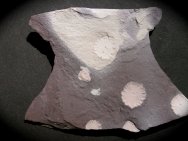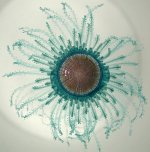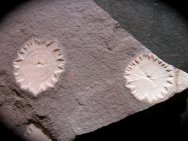Enigmatica:
resembling Porpita porpita
Phylum Incertae
sedis
But, morphologically
like:
Phylum
Cnidaria, Subphylum Medusozoa, Class Hydrozoa, Order Anthomedusae,
Family Porpitidae
Geological
Time: Ediacaran, 580 million years ago
Size: The
three complete Porpita are all a bit over 5/8” in diameter on
a 5 x 3 1/4” plate
Fossil Site:
Ranford Formation, Kunnunarra, West Australia
Fossil Code:
PFO465
Price: $265.00
 Description:
The modern analogue of these ancient fossils are Porpita porpita,
commonly known as the blue button, which is a marine organism
consisting of a colony of hydroids found in tropical waters from
California to the tropical Pacific, the Atlantic and Indian oceans.
It is often mistaken for a jellyfish, but although jellyfish
and the blue buttons are part of the same phylum (Cnidaria),
the blue button is part of the class Hydrozoa. Description:
The modern analogue of these ancient fossils are Porpita porpita,
commonly known as the blue button, which is a marine organism
consisting of a colony of hydroids found in tropical waters from
California to the tropical Pacific, the Atlantic and Indian oceans.
It is often mistaken for a jellyfish, but although jellyfish
and the blue buttons are part of the same phylum (Cnidaria),
the blue button is part of the class Hydrozoa.
The
blue button lives on the surface of the sea and consists of two
main parts:
the float and the hydroid colony. It plays
a role in the food web, as its size makes it easy prey for
several organisms. The blue button itself is a passive drifter,
meaning that it feeds on both living and dead organisms that
come in contact with it. It competes with other drifters
for food and mainly feeds off of small fish, eggs, and zooplankton.
The blue button has a single mouth located beneath the float
that is used for both the intake of nutrients as well as
the
expulsion of wastes. The bodies are persevered as they have
a silicated radial skeleton (as shown in the picture) that
is identical to the structures shown in fine sediments. prey for
several organisms. The blue button itself is a passive drifter,
meaning that it feeds on both living and dead organisms that
come in contact with it. It competes with other drifters
for food and mainly feeds off of small fish, eggs, and zooplankton.
The blue button has a single mouth located beneath the float
that is used for both the intake of nutrients as well as
the
expulsion of wastes. The bodies are persevered as they have
a silicated radial skeleton (as shown in the picture) that
is identical to the structures shown in fine sediments.
This
fossil multi-plate is from the Ediacaran Period 580 Million
Years Old from the Ranford Formation in Kunnunarra
West Australia,
which is the same formation as Zebra stone occurs. The
specimens are in an excellent state of preservation. A hand lens
will
show exceptional physiological preservation detail.
Initially
both Zebra Stone “Cupperia” and these
Porpita structures were not considered biological but
recently with a better understanding of early life of the Precambrian
these are now considered to be of biological origin.
Re
Wikipedia “aspidella” and
also “Velella” similar creatures are described.
While
there is some controversy between scientists in Australia
over these fossils structures internationally
it is quite
accepted they are Hydrozoans fossils.
These fossils are very rare and have been legally collected
and exported.
- Also see:
Ellis L. Yochelson and Charles E. Mason. 1986. A Chondrophorine
Coelenterate from the Borden Formation (Lower Mississippian)
of Kentucky, Journal of Paleontology, Vol. 60, No. 5 (Sep., 1986),
pp. 1025-1028
- Chen,
J.-Y., Oliveri, P., Gao, F., Dornbos, S.Q., Li, C-W., Bottjer,
D.J. and Davidson, E.H. (August 2002). "Precambrian Animal
Life: Probable Developmental and Adult Cnidarian Forms from Southwest
China" (PDF). Developmental Biology 248 (1): 182–196.
|
|


